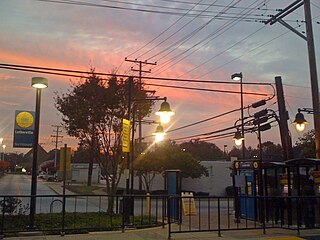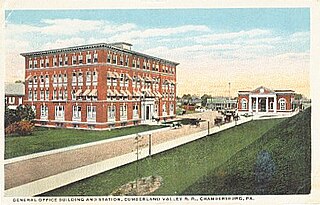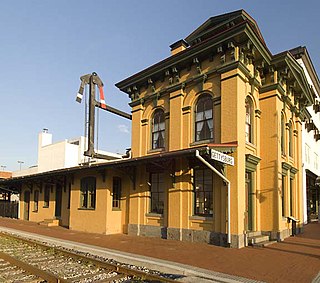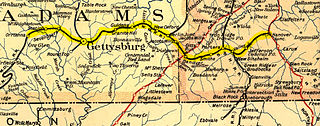
Gettysburg is a borough and the county seat of Adams County in the U.S. state of Pennsylvania. The Battle of Gettysburg (1863) and President Abraham Lincoln's Gettysburg Address are named for this town.

Cockeysville is a census-designated place (CDP) in Baltimore County, Maryland, United States. The population was 20,776 at the 2010 census.

The Gettysburg campaign was a military invasion of Pennsylvania by the main Confederate army under General Robert E. Lee in summer 1863. It was the first time during the war the Confederate Army attempted a full scale invasion of a free state. The Union won a decisive victory at Gettysburg, July 1–3, with heavy casualties on both sides. Lee managed to escape back to Virginia with most of his army. It was a turning point in the American Civil War, with Lee increasingly pushed back toward Richmond until his surrender in April 1865. The Union Army of the Potomac was commanded by Maj. Gen. Joseph Hooker and then by Maj. Gen. George G. Meade.

The Western Maryland Railway was an American Class I railroad (1852–1983) that operated in Maryland, West Virginia, and Pennsylvania. It was primarily a coal hauling and freight railroad, with a small passenger train operation.

The Northern Central Railway (NCRY) was a Class I Railroad in the United States connecting Baltimore, Maryland, with Sunbury, Pennsylvania, along the Susquehanna River. Completed in 1858, the line came under the control of the Pennsylvania Railroad (PRR) in 1861, when the PRR acquired a controlling interest in the Northern Central's stock to compete with the rival Baltimore and Ohio Railroad (B&O).

Lutherville is a census-designated place (CDP) in Baltimore County, Maryland, United States. As of the 2010 census it had a population of 6,504. Prior to 2010 the area was part of the Lutherville-Timonium CDP. Within its borders lies the Lutherville Historic District.

During the American Civil War, the Commonwealth of Pennsylvania played a critical role in the Union, providing a substantial supply of military personnel, equipment, and leadership to the Federal government. The state raised over 360,000 soldiers for the Federal armies. It served as a significant source of artillery guns, small arms, ammunition, armor for the new revolutionary style of ironclad types of gunboats for the rapidly expanding United States Navy, and food supplies. The Phoenixville Iron Company by itself produced well over 1,000 cannons, and the Frankford Arsenal was a major supply depot.

Heritage Rail Trail County Park is a National Recreation Trail rail-with-trail in Pennsylvania built in 1999 by the York County Rail Trail Authority (YCRTA). It connects with the Torrey C. Brown Rail Trail in Maryland. The trail runs along the active Northern Central Railway line and forms the southernmost part of Route J in the BicyclePA route system.

The Cumberland Valley Railroad was an early railroad in Pennsylvania, United States, originally chartered in 1831 to connect with Pennsylvania's Main Line of Public Works. Freight and passenger service in the Cumberland Valley in south central Pennsylvania from near Harrisburg to Chambersburg began in 1837, with service later extended to Hagerstown, Maryland, and then extending into the Shenandoah Valley to Winchester, Virginia. It employed up to 1,800 workers.

Camden Station, now also referred to as Camden Street Station, Camden Yards, and formally as the Transportation Center at Camden Yards, is a train station at the intersection of South Howard and West Camden Streets in Baltimore, Maryland, adjacent to Oriole Park at Camden Yards, behind the B&O Warehouse. It is served by MARC commuter rail service and local Light Rail trains.

The Gettysburg Lincoln Railroad Station, also known as the "Gettysburg Train Station," "Lincoln Train Station" or "Western Maryland Railroad Station," is a historic train station with depot, platform, museum and offices on Carlisle Street in Gettysburg, Pennsylvania. Operable from 1858 to 1942, it contributes to the Gettysburg Battlefield Historic District and is most notable as President Abraham Lincoln's point of arrival on November 18, 1863 and departure, following delivery of the Gettysburg Address. The station served as both a hospital during the battle and hub for outgoing wounded soldiers and incoming resources and supplies following the end of the war. On 2015, following several years of delays, the station, which was originally owned by the Borough of Gettysburg but was bought by the Gettysburg Foundation, the non-profit partner to the National Park Service, was placed under the purview of the National Park Service.

Hanover Junction is a small unincorporated community, which is located in south-central York County, Pennsylvania, United States, near the borough of Seven Valleys. The junction serves as a rest stop on the York County Heritage Rail Trail.

The Hanover Branch Railroad Company was a railroad that operated in Pennsylvania in the mid-19th century. The company was incorporated on March 16, 1847, and began operating trains in 1852. It represents the oldest portion of the Western Maryland Railway. It extended from the connection with the Baltimore & Susquehanna Railroad at Hanover Junction, Pennsylvania, to Hanover.

The Gettysburg Railroad was a railway line in Pennsylvania that operated from 1858 to 1870 over the 17-mile (27 km) main line from the terminus in Gettysburg to the 1849 Hanover Junction. After becoming the Susquehanna, Gettysburg & Potomac Railway line in 1870, the tracks between Gettysburg and Hanover Junction became part of the Hanover Junction, Hanover and Gettysburg Railroad in 1874, the Baltimore and Harrisburg Railway in 1886, and the Western Maryland Railway in 1917.

The Hanover Junction, Hanover and Gettysburg Railroad was a railroad line in Pennsylvania in the 19th century. The 38 mile (61 km) main line ran from Orrtanna to Hanover Junction, where it connected with the Northern Central Railway. Connections along the main line were to the Gettysburg and Harrisburg Railroad, the Bachman Valley Railroad, and the Pennsylvania Railroad.

The Round Top Branch was an extension of the Gettysburg and Harrisburg Railroad from the Gettysburg borough across the Gettysburg Battlefield to Round Top, Pennsylvania. The branch ran southward from the terminus of the railroad's main line, west of the school and St. Francis Xavier Cemetery, across the field of Pickett's Charge, south of Cemetery Ridge, east of Weikert Hill and Munshower Knoll, and through Round Top to a point between Little Round Top's east base and Taneytown Road. In addition to battlefield tourists, the line carried stone monoliths and statues for monuments during the battlefield's memorial association and commemorative eras and equipment, supplies and participants for Gettysburg Battlefield camps after the American Civil War.

The Gettysburg and Harrisburg Railroad was a railway line of Pennsylvania from Hunter's Run southward to Gettysburg in the 19th century. The north junction was with the South Mountain RR, and a crossing with the Hanover Junction, Hanover and Gettysburg Railroad's westward extension was at Gettysburg. The crossing also served as a junction for westbound trains to transfer southward across the Gettysburg Battlefield via the G. & H. R. R.'s Round Top Branch to the company's Little Round Top Park.

The Hanover Historic District is a national historic district located in Hanover in York County, Pennsylvania. Bordered roughly by Elm Avenue, Broadway, Eisenhower Drive, Hollywood Avenue, and the borough's boundary line, this district encompasses 2,632 contributing buildings, four contributing sites, three contributing structures, and one contributing object in the central business district and surrounding residential area of Hanover.

The Northern Central Railway of York is a non-profit, Civil War themed heritage railroad based in New Freedom, Pennsylvania. A reproduction 4-4-0 steam locomotive hauls passengers over 10 miles of Northern Central Railway track between New Freedom and Hanover Junction, Pennsylvania. The operation was originally named Steam into History and held its grand opening on June 1, 2013. In 2019 it took up the historical name Northern Central Railway.


























